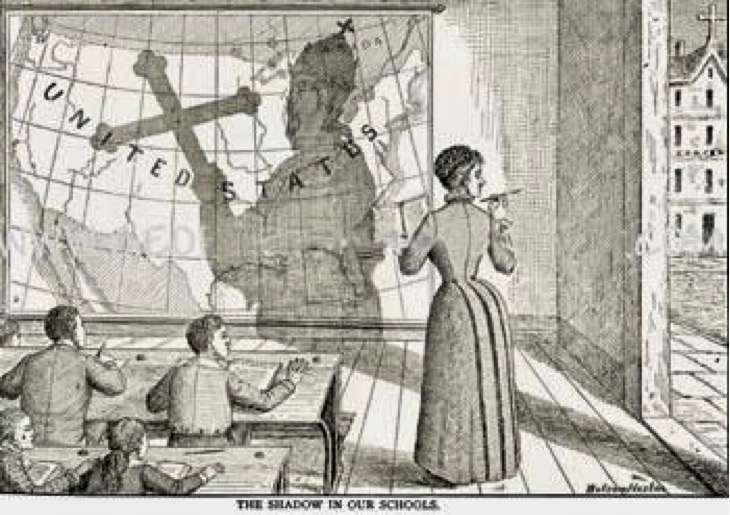The First Replacement Theory

As a result of immigration from Ireland, the Catholic population surged from 663,000 in 1841 to 3.1 million in 1860, from 4.6 percent of the population to 11.5 percent. Foreign-born people made up more than 45 percent of the populations of New York, Chicago, Milwaukee, St. Louis, Cincinnati, Buffalo, and Detroit. While early Catholic immigrants tended to be skilled workers, later arrivals were mostly poor and uneducated, many driven from Ireland by the potato famine between 1845 and 1852. Preachers, politicians, and editors sounded a clarion: America was in grave danger.
One prominent New Yorker got a great deal of attention for his nationalist tirades. A celebrity who used his fame in the commercial sector to launch a political career, he argued that a foreign country was intention- ally sending us “their criminals” because America did not have sufficient “walls” and “gates” to keep them out. While acknowledging that some immigrants might be good, he said, “we must of necessity suspect them all.” What’s more, he advocated restricting the entry of those immigrants practicing one particular religion that was, he said, associated with violence and tyranny.
The man was Samuel Morse, an inventor of the telegraph and the Morse code. The religion he assailed, of course, was not Islam but “Popery.” The nation he warned about was not Mexico, or even Ireland, but rather Austria, because he believed that an organization based there had hatched a plan to finance the immigration of hundreds of thousands of Catholics. And while Morse did not win his election (for mayorship of New York City), he had a significant influence on the popular culture through the two books he published in 1835, Foreign Conspiracy Against the Liberties of the United States and Imminent Dangers to the Free Institutions of the United States Through Foreign Immigration and the Present State of the Naturalization Laws.
The Catholic immigrants were decrepit—“halt, and blind, and naked”—and easy to manipulate, Morse wrote. With their “darkened intellects,” they “obey their priests as demigods.” The Europeans could deploy these “senseless machines” to seize power in America, Morse and other anti-Catholic activists said, through our electoral system. The Vatican controlled the priests, who then controlled the voters. Morse pointed to local elections, in which Catholics were already having an impact. A Jesuit priest had been elected to Congress from Michigan, where the Catholics used color ballots to help enforce voting discipline. “The cloven foot has already shown itself,” Morse said, via this “truly Jesuitical mode of espionage.”
“Up! Up! I beseech you. . . . Shut your gates,” Morse urged.
Lyman Beecher was just as alarmist. The immigration deluge meant “half a million of unprincipled, reckless voters, in the hands of demagogues.” How could someone like Beecher—father of abolitionist icons Harriet Beecher Stowe and Henry Ward Beecher—have not seen the irony of championing liberty while attacking Catholics? First, these anti- Catholic activists believed Catholicism was not a legitimate religion, or at least not a genuine form of Christianity (a tendency that would reappear later in the treatment of Mormons and Muslims). That’s why they used the terms “Romish,” “popery,” and “the Whore of Babylon.” The publication Home Missionary declared:
The great battle is to be fought between truth and error, between law and anarchy, between Christianity with her Sabbaths, her ministry and her schools on the one hand, and the combined forces of Infidelity and Popery on the other.
Second, they viewed Catholicism as a tool of foreign powers. Beecher explained the intentions of the European tyrants. By “emptying upon our shores” so many paupers—“the sweepings of the streets”—they would im- pose heavy burdens on our government and society. The result would be “multiplying tumults and violence, filling our prisons, and crowding our poor-houses, and quadrupling our taxation.” The American Patriot organization called for “sending back Foreign Paupers and Criminals.”
Third, Catholicism was not worthy of freedom because it opposed democracy, they believed. “Popery is a Political system, despotic in its organization, anti-democratic and anti-republican, and cannot therefore coexist with American republicanism,” Morse said. To save religious freedom in America, Catholicism would have to be defeated.
Some formerly persecuted groups joined in the attacks. The publication of the American Baptist Home Mission Society in 1832 declared of Roman Catholicism, “Its outward form is chameleon, and with Jesuitical cunning and adroitness, adopts itself to all changes of circumstances.”
While the Protestant attacks reeked of bigotry, the Catholic Church gave them plenty of ammunition. The Church at various moments of world history had opposed freedom and democracy in Europe and other parts of the world. But what anti-Catholic activists left out was any evidence that American Catholics had rejected the democratic system. After all, the primary means through which Catholics attempted to reshape America was by setting up schools and charities. And the way they were hoping to gain power was through elections.